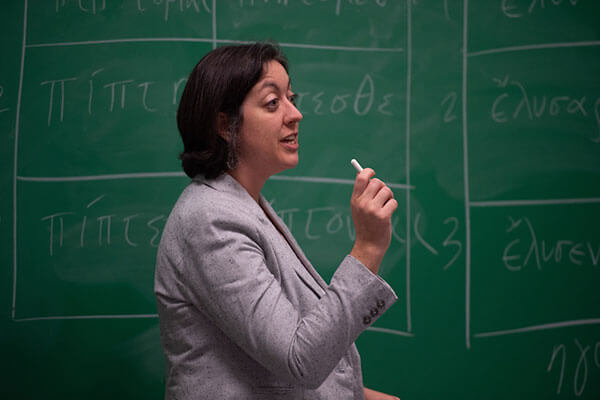May 26, 2020
In response to the coronavirus pandemic, the St. Mary’s University community has adapted — faculty stepping up to deliver quality education to students from a distance.

Allison Gray, Ph.D., Assistant Professor of Theology and Graduate Theology Program Director, shared takeaways from her spring classes in a Q&A. Gray joined St. Mary’s in 2016, specializing in early Christian literature and biblical interpretation, the New Testament and Greco-Roman history. In Spring 2020, she taught Foundations of Reflection: God, and New Testament Themes: Gospel and Letters of John.
Q: What was your approach in switching to online learning in a short period of time?
A: My approach in making the transition was to focus on two main things: 1) prioritizing opportunities for students to learn the really crucial material and skills left on each syllabus and 2) ensuring that folks who were stressed out, under pressure and possibly lacking access to materials could still succeed in their courses. To address issues of access, I chose to make my courses mainly asynchronous. Each week, students work independently to complete a checklist of tasks through Canvas, with the option to meet with me during a daily office hour. I didn’t want to require synchronous class meetings in case there was competition for a household’s computer or students traveled to places without internet (or in very different time zones). But I still wanted to make space so that students could engage with important theological concepts and talk about entertaining early Christian literature or ancient art. I transformed some assignments from papers into collaborative Google Docs so students could not only practice writing skills, but also see each other’s reactions to the material. I’ve also tried to focus more on tasks that invite students to apply new concepts to our shared current experience or to think about how ideas expressed in our texts might impact living communities.
Q: What are some new teaching methods you’ve picked up along the way?
A: I’ve appreciated the challenge of boiling down each lesson into a few major takeaway points that I can summarize in a very short video lecturette, which students can watch before doing the reading, working through a PowerPoint, and completing a quiz or post. I already try to give a quick overview of our trajectory at the start of each face-to-face class, but needing to do it in a more structured way has helped cement how essential it is to provide a clear roadmap or foundation before tackling unfamiliar material. I’m now planning to incorporate these sorts of introductions into my regular teaching so students can read or watch them alongside their reading assignments.
Q: What has been your biggest area or opportunity for growth in teaching online thus far?
A: I was really happy when I learned how to make a classy YouTube thumbnail graphic in Canva (partly so I can avoid the goofy-looking thumbnails of my face that YouTube automatically suggests, but also because it’s really satisfying to create a consistent, unified look for all videos in a single course). On a more serious note, the shift online is helping me grow in my awareness of many more ways to be present for and with students, even when we aren’t sharing a classroom space.
Q: What has been most surprising?
A: I’ve been at St. Mary’s long enough that I shouldn’t be surprised by this, but it has still been wonderful to see: Students take the time in discussion board conversations to write encouraging messages for each other and compliment each other’s work. The same kind of respectful consideration of others’ ideas that happens in the physical classroom is reproduced online, like when a student wrote, “I took the complete opposite position in my post, but your post helped me think about why someone might believe differently.” I have been very happily surprised to see the effort classmates are putting into maintaining their kind and supportive learning community.
Q: What has been the most beneficial experience of teaching online?
A: There are so many great opportunities for collaboration! My long-distance academic network has kicked into high gear. I’ve loved seeing the materials colleagues from Northeastern State and Notre Dame prepared for my students (videos and PowerPoints about cults, crime and Buddhist responses to the problem of evil). These are just small examples of the ways teachers and scholars are stepping up to support one another, and I hope the practical cooperation lasts well beyond this crisis.
Q: Students look to you for guidance, for wisdom, especially during times of crisis. How have you managed your own challenges and anxieties during this time?
A: One of the biggest challenges for me personally is keeping in mind that the way things are right now isn’t the way they will be forever; I tend to adjust quickly to a new normal but then subconsciously assume it can never change and get anxious or discouraged. Here’s where your scholar of religion talks about the amazing power of ritual! Each weekday has a reliable set of moments that can be marked, and when I move through them intentionally, I am better able to stay present instead of worrying. I usually drink tea and do crafts (knitting or cross stitch) during my Zoom office hour, which happens at the end of my work day. It’s a nice way to remind myself to step away from work tasks and just be home. Many people I usually exercise with are hosting live classes on Facebook or Zoom, so I join those as one way of keeping in touch with friends outside of St. Mary’s.
Watch the video below to learn from Gray’s video lecturette on Catholic Theological Anthropology.
